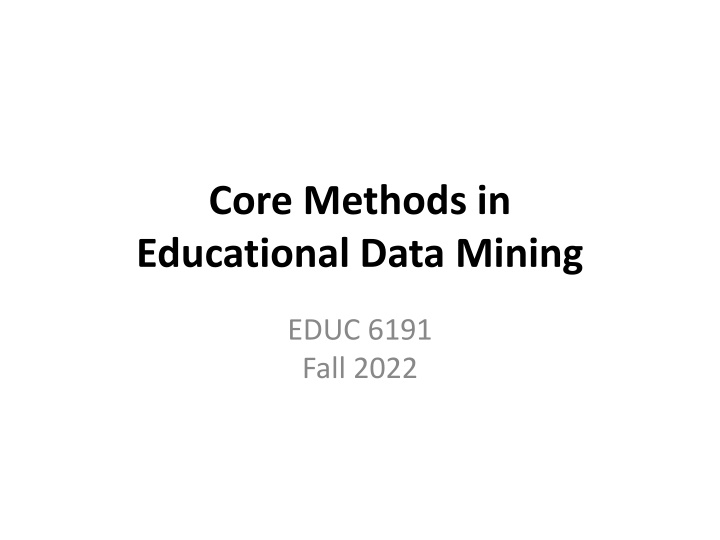
Exploring Core Methods in Educational Data Mining for Fall 2022
Dive into the world of educational data mining in EDUC 6191 for Fall 2022. Discover the final project details, presentation slots signup, and the evolving frontier of DKT-family research. Join the discussion on finding project partners and stay updated on the latest developments in deep learning frameworks.
Download Presentation

Please find below an Image/Link to download the presentation.
The content on the website is provided AS IS for your information and personal use only. It may not be sold, licensed, or shared on other websites without obtaining consent from the author. If you encounter any issues during the download, it is possible that the publisher has removed the file from their server.
You are allowed to download the files provided on this website for personal or commercial use, subject to the condition that they are used lawfully. All files are the property of their respective owners.
The content on the website is provided AS IS for your information and personal use only. It may not be sold, licensed, or shared on other websites without obtaining consent from the author.
E N D
Presentation Transcript
Core Methods in Educational Data Mining EDUC 6191 Fall 2022
Final project Let s take a few minutes to discuss the final project The end of the semester is creeping up on us
Final project Anyone who hasn t found a partner for their project yet: please raise your hand Please say your name and some topics or areas of application that are of interest to you Contact each other afterwards or post to Piazza, please
Final project If you haven t found project partners by Thanksgiving, send me an email and I ll see if I can connect people
Presentation slot signup You can sign up for a presentation slot at this link https://docs.google.com/spreadsheets/d/1c4 E0p1mDplp8UVmtNtXCCtC89Am94AdHuc4hq oHm6S0/edit?usp=sharing
Final project Any questions?
DKT-family: work continues Dozens of recent papers trying to get better results by adjusting the deep learning framework in various ways
Next Frontier for DKT-family: Beyond Correctness Option Tracing (Ghosh et al., 2021) extends output layer to predict which multiple choice item the student will select
Next Frontier for DKT-family: Beyond Correctness Open-Ended Knowledge Tracing (Liu et al., 2022) integrates KT with A GPT-2 model fine-tuned on 2.1 million Java code exercises and written descriptions of them In order to generate predicted student code which makes predicted specific errors
Discussion (if theres time) What additional information could be useful to add as inputs? How could we go further in what we predict?
Final questions on DKT-family knowledge tracing?
Q-Matrix (Tatsuoka, 1983; Barnes, 2005) Skill1 Skill2 Skill3 Skill4 Item1 1 0 0 0 Item2 1 1 0 0 Item3 1 0 1 0 Item4 0 0 0 1 Item5 0 0 1 1 Item6 0 1 0 0
Example Add Subtract Multiply Divide 7 + 3 + 2 1 0 0 0 7 + 3 - 2 1 1 0 0 (7 + 3) * 2 1 0 1 0 7 / 3 / 2 0 0 0 1 7 * 3 / 2 0 0 1 1 7 - 3 - 2 0 1 0 0
Partial Order Knowledge Spaces (Desmarais et al., 1996, 2006) Postulate relationships between items Mastery of one item is prerequisite to mastery of another item
Example (Desmarais et al., 2006) B does not inform us about C If student succeeds at C, they will succeed at D; D is prerequisite to C
Extension to skills POKS can be extended rather easily to use skills (interchangeable items) rather than items
Bayesian Networks Less restricted set of models that also infer relationships between skills and items, and between skills Can infer more complicated relationships between material than the very restricted set of relationships modeled in POKS Can infer {skill-skill, item-item, skill-item} relationships at the same time Can integrate very diverse types of information That extra flexibility can lead to over-fitting (cf. Desmarais et al., 2006)
What are the relative benefits of using a q-matrix versus a knowledge space?
What are the consequences of getting a knowledge mapping wrong?
Knowledge Structure Discovery Why would someone want to discover the knowledge structure?
Automated model discovery (from scratch) What are some ways to do this?
Automated model discovery (from scratch) What are some ways to do this? PCA/Factor Analysis Barnes s method NNMF DKVMN/KQN What situation does each apply in?
Automated model discovery (from scratch) What are the advantages and disadvantages of those approaches?
Hand development and refinement What are the advantages and disadvantages of this type of approach?
Hybrid approach: Learning Factors Analysis Does anyone remember this from the lecture?
Hybrid approach: LFA What are the advantages and disadvantages?
What does a spike in a learning curve mean? 70 60 50 Error Rate 40 30 20 10 0 1 2 3 4 5 6 7 8 Opportunities to Practice Skill
70 60 50 Error Rate 40 30 20 10 0 1 2 3 4 5 6 7 8 Opportunities to Practice Skill
What are the trade-offs Between Knowledge Spaces And Bayes Nets ?
Upcoming Classes November 22 SPECIAL DAY ALL VIRTUAL CLASS NO RYAN OFFICE HOURS Cluster Analysis Creative: Knowledge Structure due December 1 IN-PERSON CLASS: GUEST LECTURER STEFAN SLATER NO RYAN OFFICE HOURS Correlation Mining Basic: Clustering due December 8 Reinforcement Learning Basic: Correlation Mining due December 15 Final Project Presentations, 11a-12p AND 3p-450p
